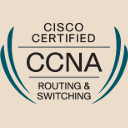The five Ws
-
What: CCNA Routing & Switching is a technical certification about enterprise-grade IT networking from Cisco. It covers the involved devices, protocols and how to implement them using Cisco technologies.
-
When: This is an entry-level certification with no prerequisite.
-
Why: This certification demonstrate a good level of familiarity with enterprise networks and Cisco’s IOS-based devices.
It is a de-facto standard in terms of IT networking certification, valuable even for employers using different technologies than Cisco, and is also a prerequisite for several other Cisco certifications.
Note
Note that Cisco certifications may not have the actual CCNA R&S certification as a prerequisite, but the CCENT instead which is half of the CCNA R&S.
If you are interested in networking (and I expect you are when you intend to pass a Cisco exam) I warmly encourage you to pass the full CCNA R&S certification instead of …


